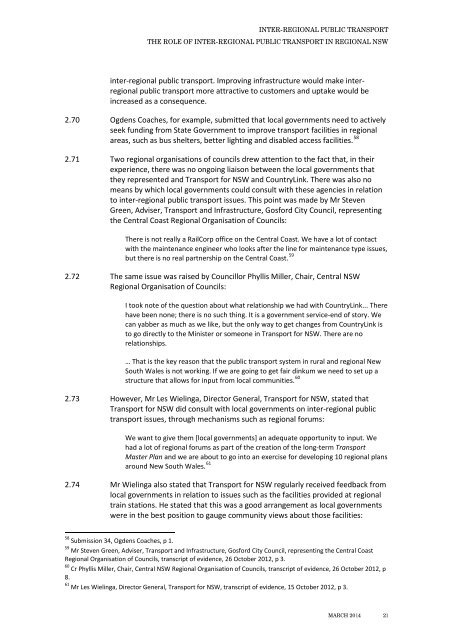Report 1-55 - Inter-regional Public Transport
Report 1-55 - Inter-regional Public Transport
Report 1-55 - Inter-regional Public Transport
You also want an ePaper? Increase the reach of your titles
YUMPU automatically turns print PDFs into web optimized ePapers that Google loves.
INTER-REGIONAL PUBLIC TRANSPORTTHE ROLE OF INTER-REGIONAL PUBLIC TRANSPORT IN REGIONAL NSWinter-<strong>regional</strong> public transport. Improving infrastructure would make inter<strong>regional</strong>public transport more attractive to customers and uptake would beincreased as a consequence.2.70 Ogdens Coaches, for example, submitted that local governments need to activelyseek funding from State Government to improve transport facilities in <strong>regional</strong>areas, such as bus shelters, better lighting and disabled access facilities. 582.71 Two <strong>regional</strong> organisations of councils drew attention to the fact that, in theirexperience, there was no ongoing liaison between the local governments thatthey represented and <strong>Transport</strong> for NSW and CountryLink. There was also nomeans by which local governments could consult with these agencies in relationto inter-<strong>regional</strong> public transport issues. This point was made by Mr StevenGreen, Adviser, <strong>Transport</strong> and Infrastructure, Gosford City Council, representingthe Central Coast Regional Organisation of Councils:There is not really a RailCorp office on the Central Coast. We have a lot of contactwith the maintenance engineer who looks after the line for maintenance type issues,but there is no real partnership on the Central Coast. 592.72 The same issue was raised by Councillor Phyllis Miller, Chair, Central NSWRegional Organisation of Councils:I took note of the question about what relationship we had with CountryLink... Therehave been none; there is no such thing. It is a government service-end of story. Wecan yabber as much as we like, but the only way to get changes from CountryLink isto go directly to the Minister or someone in <strong>Transport</strong> for NSW. There are norelationships.… That is the key reason that the public transport system in rural and <strong>regional</strong> NewSouth Wales is not working. If we are going to get fair dinkum we need to set up astructure that allows for input from local communities. 602.73 However, Mr Les Wielinga, Director General, <strong>Transport</strong> for NSW, stated that<strong>Transport</strong> for NSW did consult with local governments on inter-<strong>regional</strong> publictransport issues, through mechanisms such as <strong>regional</strong> forums:We want to give them [local governments] an adequate opportunity to input. Wehad a lot of <strong>regional</strong> forums as part of the creation of the long-term <strong>Transport</strong>Master Plan and we are about to go into an exercise for developing 10 <strong>regional</strong> plansaround New South Wales. 612.74 Mr Wielinga also stated that <strong>Transport</strong> for NSW regularly received feedback fromlocal governments in relation to issues such as the facilities provided at <strong>regional</strong>train stations. He stated that this was a good arrangement as local governmentswere in the best position to gauge community views about those facilities:58 Submission 34, Ogdens Coaches, p 1.59 Mr Steven Green, Adviser, <strong>Transport</strong> and Infrastructure, Gosford City Council, representing the Central CoastRegional Organisation of Councils, transcript of evidence, 26 October 2012, p 3.60 Cr Phyllis Miller, Chair, Central NSW Regional Organisation of Councils, transcript of evidence, 26 October 2012, p8.61 Mr Les Wielinga, Director General, <strong>Transport</strong> for NSW, transcript of evidence, 15 October 2012, p 3.MARCH 2014 21


